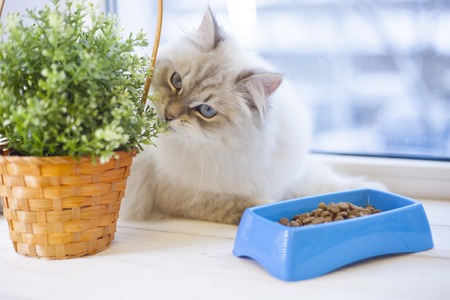Understanding Your Cat’s Eyes
Cats’ eyes are not just mesmerizing—they’re also highly specialized for their unique needs as hunters and companions. Feline vision is distinct from human sight in several fascinating ways, making eye care a crucial aspect of your cat’s health. Cats are crepuscular animals, meaning they’re most active during dawn and dusk. Their eyes have evolved to maximize light intake in low-light environments, giving them a powerful advantage when hunting or playing at night.
Unique Features of Feline Vision
The anatomy of a cat’s eye includes several adaptations for enhanced vision. One standout feature is the tapetum lucidum, a reflective layer behind the retina that amplifies available light and gives cats their signature “glowing” eyes at night. Additionally, cats have vertically slit pupils that can expand dramatically, allowing for rapid adjustments to changing light conditions. These features help them detect even the slightest movements in dim environments.
Common Eye Colors in Cats
Cat eyes come in a range of stunning colors, often influenced by breed and genetics. Here’s a quick overview:
| Eye Color | Common Breeds | Notes |
|---|---|---|
| Copper/Amber | British Shorthair, Maine Coon | Warm hues ranging from gold to deep orange |
| Green | Russian Blue, Egyptian Mau | Vivid green shades are especially prized |
| Blue | Siamese, Ragdoll | Often found in pointed breeds; associated with kittens |
| Yellow/Gold | Bengal, Burmese | Bright yellow is common among mixed breeds too |
Why Are Cat Eyes So Striking?
Cats’ eyes are naturally captivating due to their vibrant colors, intense gaze, and remarkable reflectiveness. The combination of large corneas, specialized retinas, and dramatic pupils makes their expressions deeply engaging—and sometimes mysterious! This striking appearance isn’t just aesthetic; it’s a testament to how well-adapted cats are to their environment. Understanding these features helps pet owners appreciate both the beauty and the importance of caring for their feline friends’ vision.
2. Recognizing Signs of Eye Problems
Keeping your cat’s eyes healthy means spotting trouble early. Just like people, cats can develop a range of eye issues that are easier to treat if caught quickly. Knowing the warning signs can help you act before minor discomfort becomes a bigger problem. Here are some common indicators that your cat may be experiencing eye problems:
| Sign | What to Look For |
|---|---|
| Redness | Unusual pink or red coloring in the whites of the eyes or eyelids |
| Squinting | Your cat keeps one or both eyes partially closed, blinks excessively, or seems sensitive to light |
| Discharge | Tears, mucus, or pus coming from the eyes; can be clear, yellow, green, or white |
| Cloudiness | The surface of the eye looks hazy or has a bluish-white film |
If you notice any of these symptoms, it’s important to monitor your cat closely and consult with your veterinarian. Early intervention not only protects your cat’s vision but also helps prevent discomfort and more serious health issues. Remember, healthy eyes should be bright and clear with no unusual discharge or color changes.

3. Routine Eye Care Tips for Cat Owners
Keeping your cat’s eyes healthy and clear starts with consistent at-home care. Regular attention helps you spot early signs of irritation or infection, allowing for prompt veterinary intervention if needed. Here are practical tips to help you maintain your cats eye health:
Gentle Cleaning Techniques
Use a soft, damp cotton pad or clean cloth to gently wipe away any discharge or debris from the corners of your cat’s eyes. Always use a separate pad for each eye to prevent cross-contamination, and avoid using human eye drops or harsh chemicals.
Safe Eye Inspection Steps
- Wash your hands thoroughly before handling your cat.
- Find a well-lit area and calmly approach your cat.
- Gently lift the eyelid to inspect for redness, cloudiness, swelling, or excessive tearing.
- If you notice anything unusual, consult your veterinarian promptly.
Maintaining Good Eye Hygiene at Home
Proper hygiene is key to preventing common feline eye problems. The following table summarizes essential home care practices:
| Eye Care Practice | Description |
|---|---|
| Clean Bedding & Environment | Keep your cat’s sleeping area free from dust and allergens that can irritate eyes. |
| Balanced Diet | A nutritious diet supports overall eye health and strengthens immunity. |
| Regular Grooming | Brush away loose hair around the face to prevent it from getting into the eyes. |
When to Seek Professional Help
If your cat exhibits persistent squinting, pawing at the eyes, color changes in the iris, or green/yellow discharge, these may be signs of an underlying condition requiring veterinary attention. Early detection is crucial for effective treatment and preserving your cat’s vision.
4. Common Eye Conditions in Cats
Cats, like people, can experience a variety of eye problems that impact their vision and overall well-being. Being familiar with the most common feline eye conditions helps you spot trouble early and get your cat the care they need. Here are some frequent issues:
| Condition | Description | Signs to Watch For |
|---|---|---|
| Conjunctivitis (Pink Eye) | Inflammation of the tissue lining the eyelids and eyeball surface; often caused by infections or allergies. | Redness, swelling, discharge (clear, yellow, or green), squinting, frequent pawing at eyes. |
| Cataracts | Cloudiness of the eye lens, leading to impaired or lost vision; more common in older cats or those with diabetes. | Cloudy or bluish appearance in the pupil, clumsiness, reluctance to jump or play. |
| Corneal Ulcers (Scratched Corneas) | Damage to the clear outer layer of the eye due to trauma, infection, or foreign bodies. | Tearing, excessive blinking, holding eye closed, visible scratch or cloudiness on cornea. |
Why Prompt Attention Matters
Cats tend to hide discomfort until an issue becomes severe. Quick identification and treatment of eye problems can prevent pain, permanent vision loss, or even blindness. If you notice any changes in your cat’s eyes—such as redness, swelling, discharge, cloudiness, or behavioral changes—schedule a veterinary visit right away. Early intervention is key to keeping your cat’s vision clear and healthy.
5. When to Seek Veterinary Help
As a responsible cat owner, it’s crucial to know when your feline friend needs professional attention for their eyes. Early intervention can make a big difference in preserving your cat’s vision and overall health. Below, we’ll guide you on recognizing the warning signs, what to expect during a veterinary eye exam, and how acting quickly can protect your cat from long-term problems.
Recognizing Red Flags: When Should You Call Your Vet?
Cats are masters at hiding discomfort, so keep an eye out for these symptoms that signal it’s time for a vet visit:
| Symptom | What You Might Notice | Possible Concerns |
|---|---|---|
| Redness or Swelling | Puffy eyelids, red eyes, or visible irritation | Infection, allergies, injury |
| Discharge | Watery, yellow, green, or crusty build-up around the eye | Conjunctivitis, blocked tear ducts, infection |
| Cloudiness or Change in Eye Color | Hazy appearance or blue/gray film over the eye | Cataracts, glaucoma, corneal ulcers |
| Squinting or Excessive Blinking | Your cat keeps one or both eyes partly closed or blinks more than usual | Pain, injury, foreign object in eye |
| Pawing at Eyes or Face | Your cat frequently rubs its face with paws or against furniture | Irritation, discomfort, infection |
| Behavioral Changes | Bumping into objects, reluctance to jump or play, hiding more often | Vision loss or severe discomfort |
What Happens During a Feline Eye Exam?
If you notice any of the symptoms above, schedule a visit with your veterinarian as soon as possible. Here’s what you can expect during an eye exam:
- History & Observation: The vet will ask about your cat’s recent behavior and symptoms.
- Physical Examination: They’ll gently inspect your cat’s eyes using a bright light and magnifying lens.
- Tear & Pressure Tests: These help check for dry eye and glaucoma.
- Dye Tests: Special drops may be used to highlight scratches or ulcers on the cornea.
- Treatment Plan: Depending on findings, your vet might prescribe medication, suggest follow-up visits, or refer you to a veterinary ophthalmologist.
The Importance of Early Intervention
Catching eye problems early means less pain and better outcomes for your cat. Prompt treatment can resolve minor issues before they become major threats to eyesight—or even overall health. Remember: if you’re ever unsure about your cat’s eyes or vision changes, it’s always better to err on the side of caution and consult your vet!
6. Preventing Eye Injuries and Irritation
Keeping your cat’s eyes healthy goes beyond regular cleaning—it also means creating a safe environment that minimizes the risk of injuries and irritation. Cats, especially curious kittens, can easily get into trouble around the house, so taking proactive steps is crucial for their eye care.
Kitten-Proofing Your Home
Just like you would baby-proof for a toddler, kitten-proofing helps protect your furry friend from accidents. Make sure to:
- Remove sharp objects: Keep scissors, needles, and other sharp items out of reach.
- Secure windows and screens: Prevent accidental falls or exposure to outdoor hazards.
- Store chemicals safely: Cleaners, detergents, and sprays should be stored in cabinets with childproof locks.
Minimizing Harm from Household Hazards
| Hazard | Potential Risk to Eyes | Prevention Tips |
|---|---|---|
| Chemicals & Cleaners | Irritation, burns | Keep stored away; clean spills immediately |
| Houseplants (e.g., lilies) | Toxicity, scratching cornea | Avoid toxic plants; use pet-safe varieties only |
| Cords & Strings | Scratching or poking eyes | Tie up cords; provide supervised play only |
| Toys with small parts | Eye injury from sharp pieces | Choose sturdy, cat-safe toys without detachable parts |
| Scented sprays/aerosols | Irritation from airborne particles | Avoid spraying near your cat; ventilate rooms well after use |
Promoting Safe Playtime
Cats love to pounce and chase, but not all toys are created equal when it comes to eye safety. Opt for soft toys, feather wands used under supervision, and interactive laser pointers (never shine directly in your cat’s eyes). Avoid toys with sharp edges or strings that can snap back.
Keeps These Safe Play Guidelines in Mind:
- Supervise play: Especially with new toys or in unfamiliar environments.
- Inspect toys regularly: Discard damaged or broken items immediately.
- Create a “cat zone”: Designate a room or corner free of hazards where your cat can play safely.
- Avoid roughhousing: Teach children gentle ways to interact with pets to prevent accidental pokes or scratches to the eyes.
Your Cat’s Vision Is Worth Protecting!
With a little planning and awareness, you can help your cat avoid painful eye injuries and keep their vision bright for years to come. A safe home is the foundation of healthy feline eyes!
7. Maintaining Healthy Vision as Cats Age
As your cat enters their senior years, their needs change, and so does the care required to maintain clear, healthy vision. Just like humans, aging cats are more susceptible to eye problems such as cataracts, glaucoma, and retinal diseases. Proactive steps can make a significant difference in supporting your feline friend’s eyesight throughout every stage of life.
Common Age-Related Eye Issues in Cats
| Condition | Symptoms | Recommended Action |
|---|---|---|
| Cataracts | Cloudy or bluish eyes, reduced vision | Regular vet exams, possible surgery for severe cases |
| Glaucoma | Redness, pain, enlarged eye, vision loss | Immediate veterinary attention; may require medication or surgery |
| Retinal Degeneration | Night blindness, dilated pupils, bumping into objects | No cure but supportive care can help manage symptoms |
| Dry Eye (Keratoconjunctivitis Sicca) | Tearing, discharge, inflamed conjunctiva | Prescription eye drops and regular cleaning |
How to Support Your Senior Cat’s Eye Health
- Schedule Regular Vet Visits: Annual (or semi-annual) wellness checks are crucial for early detection of age-related changes.
- Create a Safe Environment: Keep furniture arrangements consistent and avoid adding obstacles that could confuse a visually impaired cat.
- Monitor for Behavioral Changes: If your cat seems hesitant to jump or navigate familiar spaces, it could signal declining vision.
- Provide Proper Nutrition: Diets rich in antioxidants like vitamin E and beta-carotene can help support ocular health.
- Keeps Eyes Clean: Gently wipe away discharge with a damp cotton ball to prevent infection.
- Avoid Irritants: Reduce exposure to smoke, harsh cleaning agents, or perfumes that could aggravate sensitive senior eyes.
Nutritional Supplements That Benefit Aging Eyes
| Supplement | Benefit for Eye Health | Sources/Notes |
|---|---|---|
| Lutein & Zeaxanthin | Protects retina from oxidative damage | Available in commercial senior cat foods or supplements |
| Taurine | Essential for feline vision; deficiency causes blindness | Main ingredient in quality cat foods; supplements if recommended by vet |
| Omega-3 Fatty Acids (DHA/EPA) | Aids in retinal function and reduces inflammation | Sourced from fish oil capsules or specialized diets |
Caring for Your Cat’s Vision—A Lifelong Commitment
Your dedication to eye care ensures your cat enjoys a comfortable life well into their golden years. Watch for subtle signs of trouble and consult your veterinarian whenever you notice changes. With proper support and attention, you can help your feline companion see the world clearly at every age.

